It’s pretty rare to get a flat tire when you have a tubeless setup. The sealant inside your tires will quickly seal small holes and cuts to keep you rolling on the road or trail. However, flats are always possible – even with tubeless. Whether you’ve discovered your tire is flat after storing it in the garage, or you lose pressure after a sudden impact with a rock, we have you covered with the tips you need. Check out our guide to fixing your tubeless flat and getting back out on your ride.
You also might need:

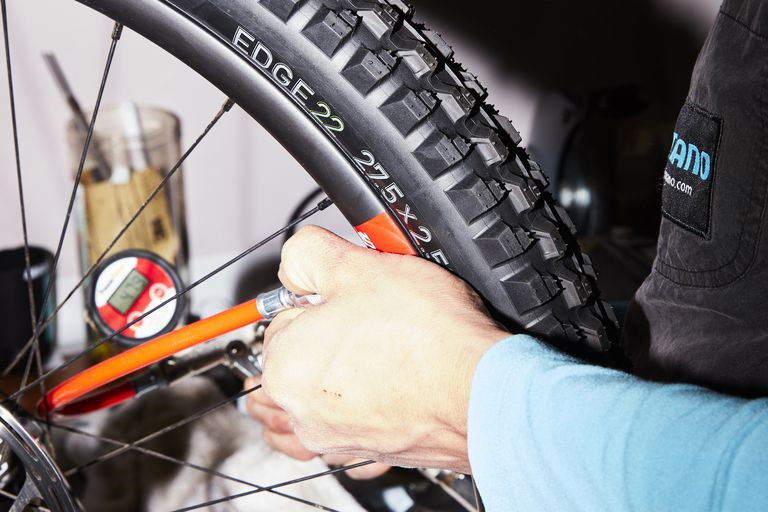
PRO TIP: Opt for plastic tire levers over metal ones. They won’t scratch the surface of your rim and they are lighter and easier to carry!
 If you find a large hole or gash in the tire that cannot be fixed with sealant alone, you’ll need to patch the tire and you might even need to install a tube until you arrive home.
If you find a large hole or gash in the tire that cannot be fixed with sealant alone, you’ll need to patch the tire and you might even need to install a tube until you arrive home.PRO TIP: If the last bit is super tight, start back at the top and use your hands to wiggle the tire into the center of the rim. Just like you did at the beginning to loosen the bead from the rim, this creates extra slack in the tire and will make it easier to get onto the rim. While you wiggle the tire push down. When you get to the bottom, you might be able to pop that tire on with your bare hands!

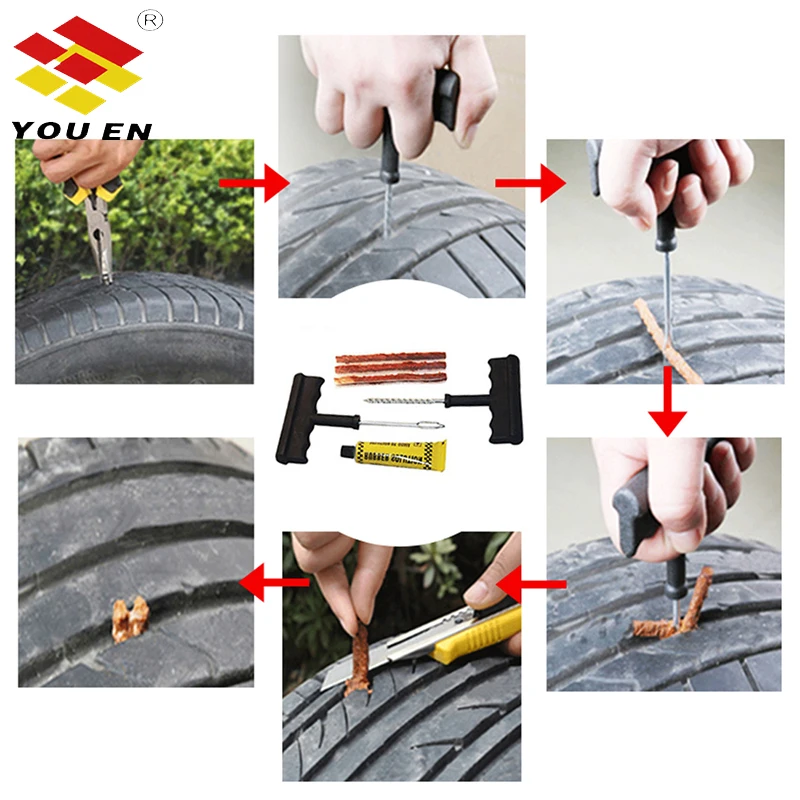 Then, just give it a spin and squeeze your brake to make sure everything works like it should. Nice job!
Then, just give it a spin and squeeze your brake to make sure everything works like it should. Nice job!How to Choose the Right Saddle
How to Store Multiple Bikes and Gear in Small Spaces
How to Adjust Your Suspension on the Trail
How to Adjust a Dropper Post
How to Set Up Mountain Bike Suspension
Get Your Printable Fix-a-Flat Zine
How to Fix a Flat Tire | Tubeless
How to Fix a Flat with a Tube
Top Five Bike Maintenance Tips
What to Pack for an Epic Mountain Bike Ride
How I Became a Professional Bike Mechanic
How to Use a Torque Wrench
How to Select Mountain Bike Tires
How to Select Road Bike Tires
How to Perform a Safety Check on Your Bike
The Importance of Proper Bike Fit
How to Prep Your Bike for Riding in the Rain
How to Replace Disc Brake Pads and Rotors
How to Cut MTB Handlebars
Trailside Bike Repair Fix Guide
How to Setup Tubeless Tires
How to Silence Common Bike Noises
How to Replace Handlebar Tape on a Road Bike
How to Pack and Ship a Bike
How to Wash a Bike
How to Adjust a Bike Derailleur
How to Repair a Broken Bike Chain
How to Make a Wall-Mounted Shelf to Hang your Bike
How to Make a Bike Hook out of Pipe Fittings
How to Carry a Yoga Mat on a Bike
Removing and Reinstalling a Bike Wheel for Transport
How to Navigate the Subway with a Bike
How to Lock your Bike in a City
Parts of the Bike
How to Fix Squeaky Disc Brakes
Bike Safety | Hand Signals and Riding Tips
Cycling at Night: How to Light Up Your Bike
The sealant used in a tubeless tyre setup is designed to quickly plug small holes, often without you even realising.
However, sometimes the size or the location of the puncture will require more than sealant to fix it.
Here’s how to repair a punctured tubeless tyre using tubeless plugs, patches or sewing.
Tubeless punctures are often easy to find: look for tell-tale sealant or listen for the hissing of lost air pressure.Immediate Media
These days, a tubeless plug kit is a key part of any rider’s tool kit.Steve Behr
To repair a tubeless tyre puncture, you will require
For a more serious or stubborn puncture, you may need a tyre patch and/or a needle and thread.
If your sealant has dried out, you might need to refresh it.Russel Burton
You may also require:
Tubeless puncture plugs are a quick and effective solution. With these, there is no need to take off the tyre – just plug, re-inflate and go.
With these, there is no need to take off the tyre – just plug, re-inflate and go.
While there are a number of tubeless repair kits out there, most work in a similar way, using a rubber plug to fill the hole.
Once you’ve found the puncture, remove any offending items (a pick or a small pair of pliers are a useful addition to your tool bag for this very purpose).
Next, use your tubeless plug tool to make sure there’s a sufficiently large hole for the plug to enter – carefully insert the spike into the tyre to avoid damaging the rim tape, and twist to give a clean, round hole.
Thread a tubeless plug through the head of the tubeless plug tool. Most tools will come with a choice of different plug sizes to suit the size of the hole.
With the plug in the centre of the tool, insert it into the tyre, making sure you don’t push through fully.
Then twist carefully to slowly remove the tool, leaving the two ends of the plug on the outside of the tyre.
Inflate the tyre to your desired pressure, taking additional caution with high-pressure road tyres, and rotate the wheel so that the plug is at the ground for a few minutes before you get going again. This will allow some sealant to flow into the repair and fully seal things.
This will allow some sealant to flow into the repair and fully seal things.
You may need to trim the tails of the plug that are left behind, but take care not to cut it too close to the tyre.
For more stubborn tubeless tyre punctures that can’t be fixed with a plug, it may be necessary to patch the tyre internally. The process for this is very similar to patching an inner tube.
First, you’ll need to roughen the surface that you want your patch to adhere to, using a little sandpaper, making sure there’s no debris left from the puncture. Cleanliness is key when it comes to gluing patches.
Add some vulcanising rubber solution to the area where you want to add the patch, waiting for it to become tacky as per the kit instructions.
Add the tubeless tyre patch and press down firmly. Try to avoid touching the surface that is to be glued because this can contaminate the adhesive.
Depending on the patch type, these may need minutes or hours to dry, before setting the tyre up tubeless as normal.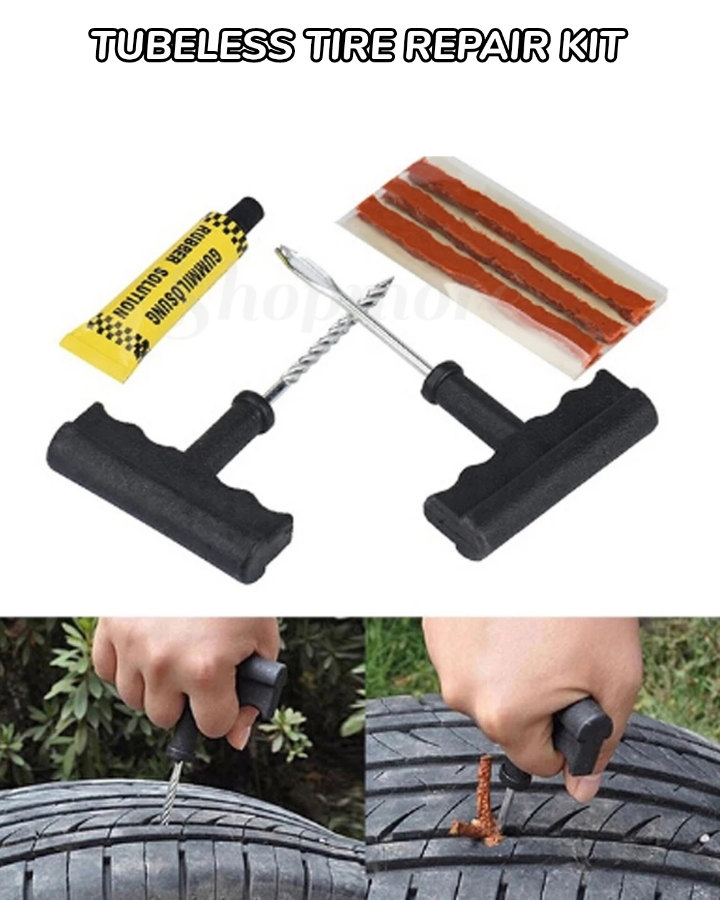
If successful, a patched tubeless tyre can last for many rides, often to the end of the tyre’s life.
A torn tyre can be a rider’s worst nightmare. These repair options should be viewed as a way to help you limp home before fitting a new tyre, rather than a long term solution.
A tyre boot can be placed on the interior of the tyre without any adhesive, held in place by the addition of an inner tube.
This flat boot keeps a flush internal surface to prevent the inner tube from bulging out of the slashed tyre. You can buy pre-made boots or make one out of a number of materials: toothpaste tubes, a section of inner tube or cash notes all work surprisingly well.
You’ll need a strong thread and needle to sew a tyre, such as this thick nylon or tooth floss.Immediate Media
If you don’t have a boot but you do happen to have tooth floss and a needle, you can actually sew up a torn tubeless tyre.
Using stitches perpendicular to the direction of the slash can help hold the casing of the tyre together before you insert an inner tube.
If you do use this method, it’s a good idea to add something between the sewn rubber and inner tube, such as a strip of strong tape.
If you are heading to the hills for an extended bikepacking or touring trip, packing a needle and thread is a good idea for this and any other fabric repairs.
No matter how hard you try, there’s always the chance a tubeless tyre might not be fixable on the road or trailside. Inserting an inner tube can be a mucky business with sealant already in the tyre, so it’s generally a last resort.
Before fitting an inner tube, thoroughly check the tyre for any punctures or offending items such as thorns. Just because you’ve found one, doesn’t mean there won’t be more embedded in the rubber waiting to puncture your inner tube too!
You can still get snakebite punctures with tubeless too, so make sure you’re running adequate pressures in your tyres, especially over harsh or rocky terrain to avoid a nasty double puncture from an impact on the rim.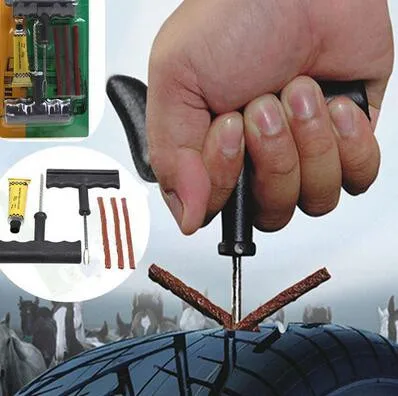 These are notoriously tricky to fix, with holes often too close to the tyre bead.
These are notoriously tricky to fix, with holes often too close to the tyre bead.
Besides punctured tyres, there are other things that need careful maintenance to keep your tubeless set up running smoothly, including the rim tape, tubeless valves and sealant.
It can be pretty hard to sort these on the go, so that’s when you might need to pop in a tube and leave the closer inspection until you’re home.
Katherine Moore is Bristol-based gravel and bikepacking expert who judges her rides by stoke level, rather than speed. When she’s not scouting out the best long-distance and local off-road routes in the UK, Katherine works as a freelance writer, bike tester, presenter and guide. Katherine is the former editor of advntr.cc and has also worked as a presenter on the Global Cycling Network. As well as being a regular contributor to BikeRadar.com and the BikeRadar Podcast, Katherine has also written for Cycling Weekly, Bikepacking. com and hosts the Unpaved Podcast. If you’re out on the trail you’ll likely see her from a mile off, thanks to her rather bright colour palette!
com and hosts the Unpaved Podcast. If you’re out on the trail you’ll likely see her from a mile off, thanks to her rather bright colour palette!
5/5 - (1 vote)
Tubeless technology has revolutionized riding both on and off road, but it is not completely safe.
Tubeless tire sealant designed to quickly seal small holes, often without your knowledge. However, sometimes the size or location of the puncture requires more than sealant.
Tubeless punctures are often easy to find: look for leaking sealant or listen for the hiss of escaping air.
Here's how to repair a tubeless tire puncture using tubeless plugs, patches or sewing.
Contents
Tools needed to repair a tubeless tire puncture.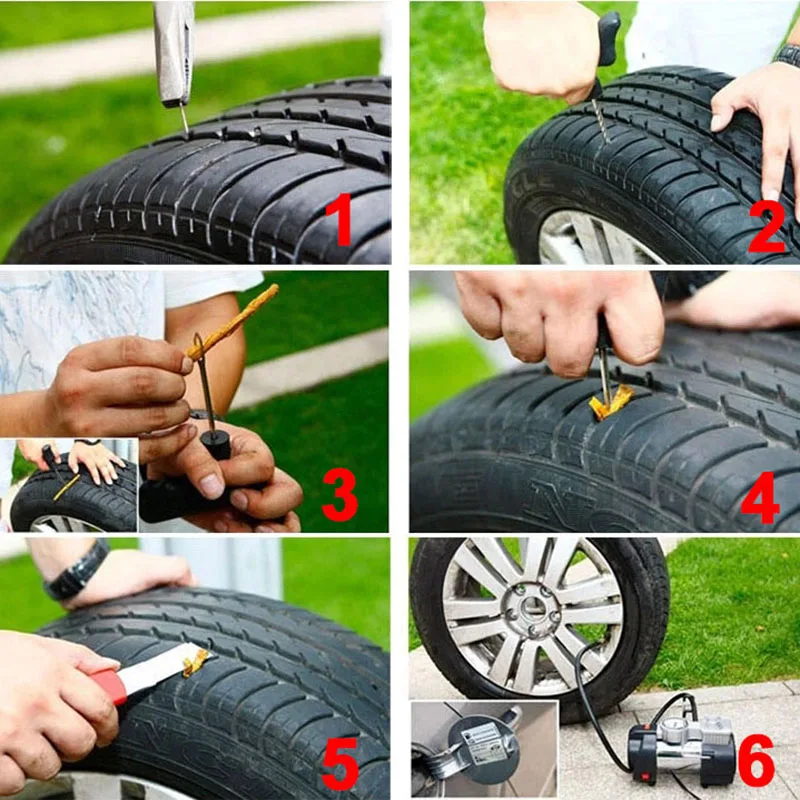
To repair a tubeless tire puncture you will need
You may also need:
Tubeless puncture plugs are a quick and effective solution. With them, you do not need to remove the tire - just plug it in, pump it up and go.
While there are many tubeless repair kits, most work in a similar way, using a rubber plug to fill the hole.
Carefully rotate the tubeless plug tool as a reamer to prepare the plug piercing.
Select tubeless plug size according to puncture size.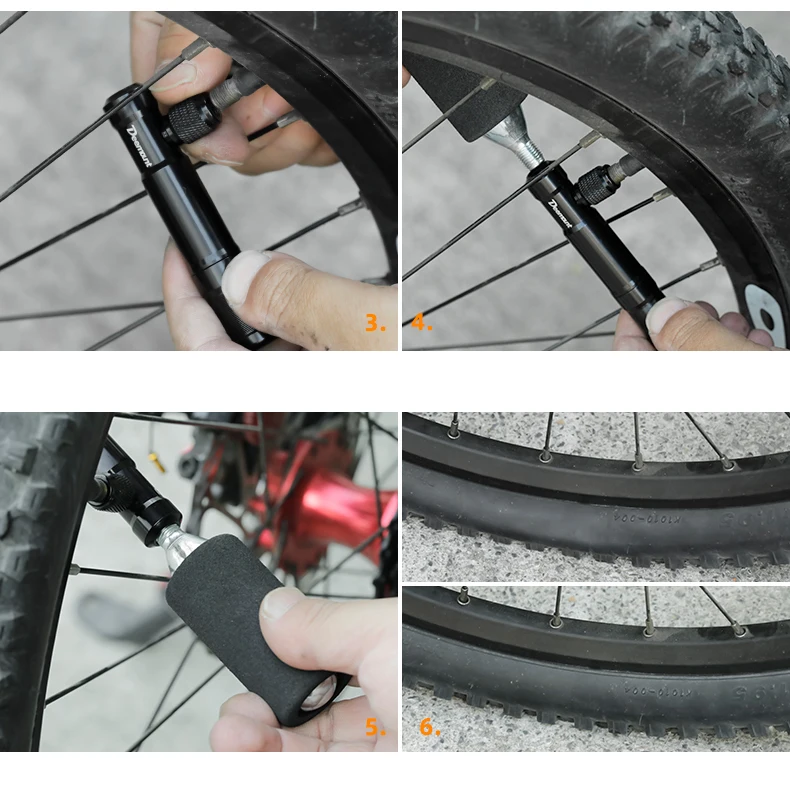
Carefully use the tubeless plug tool to insert the plug without damaging the rim tape or losing the plug from the inside.
Tubeless plug tails must be visible from outside when installed.
Trim the open ends of the tubeless plug carefully to avoid damaging the tire.
Tubeless cork may be barely visible in the tread after cutting.
After finding the puncture site, remove any obstructions (you can put small pliers in the tool bag for this).
Next, use a tubeless plug tool to make sure the hole is large enough to insert the plug - carefully insert the spike into the tire to avoid damaging the rim tape and twist to make a clean round hole.
Insert the tubeless plug through the head of the tubeless plug tool. Most tools come with different plug sizes to match the size of the hole.
With the plug in the center of the tool, insert it into the bar without pushing it all the way through.
Then carefully turn the tool and slowly remove it, leaving the two ends of the cork outside the tire.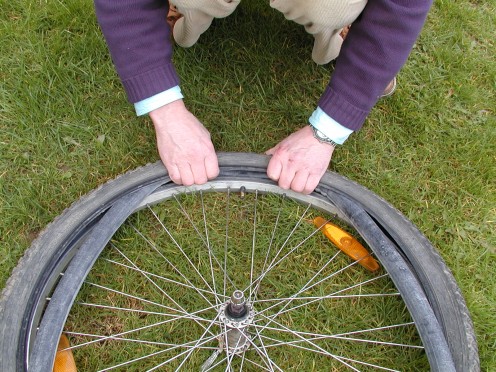
Inflate the tire to the desired pressure, being especially careful with high pressure road tires, and turn the wheel so that the valve is on the ground for a few minutes before driving again. This will allow the sealant to seep into the repair area and completely seal it.
You may need to cut off the remaining pin tails, but be careful not to cut them too close to the bar.
For more severe tubeless punctures that cannot be repaired with cork, internal patching may be required. This process is very similar to patching a camera.
A small piece of sandpaper or metal can be used to roughen the area where you want to place the patch for better adhesion.
Add the vulcanizing rubber solution to the affected area and wait until it becomes tacky before applying the patch.
Added tubeless tire patch to prevent air leakage from inside the tire.
First sand the surface to which the patch will be bonded, making sure there is no debris from the puncture.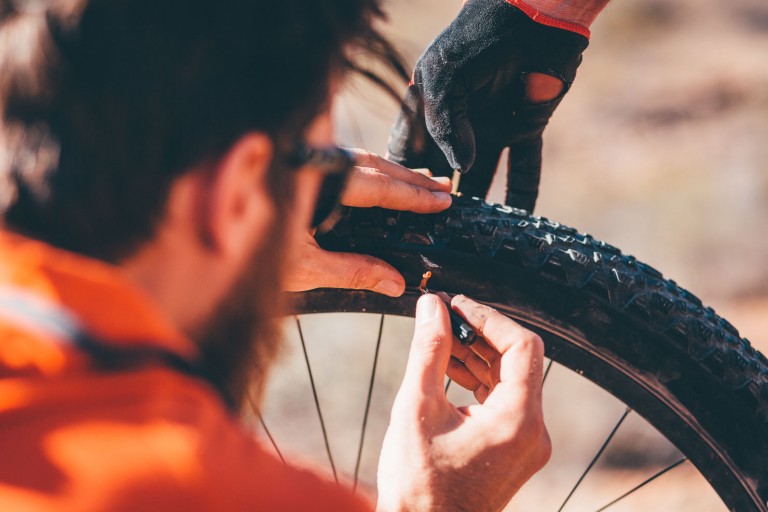 Cleanliness is key when patching.
Cleanliness is key when patching.
Add a small amount of vulcanizing rubber solution to the patch site and wait until it becomes tacky according to kit instructions.
Apply the tubeless patch and press firmly. Avoid touching the bonded surface as this may contaminate the adhesive.
Depending on the type of patch, it may take several minutes or hours to dry, then install the tubeless tire as normal.
If repaired successfully, a patched tubeless tire can last for many trips, often to the end of the tire's life.
A blown tire can be a cyclist's worst nightmare. These repair options should be seen as a way to help you get home before your new tire is fitted, not as a long-term solution.
A tire liner can be placed on the inside of a tire without any adhesive, held in place by adding an inner tube.
Larger tread or sidewall section may be harder to fix and will require insertion and/or sewing to get home.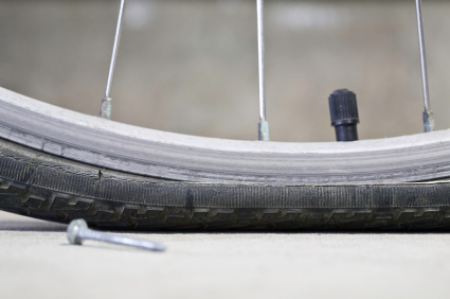
If you don't have a tire case, you can use a few different things to improvise. Money bills or parts of a tube of toothpaste work well.
A dozen in your toolbox can save you more than once!
This flat liner provides a flat inner surface to prevent the tube from popping out of a cut tire. You can buy pre-made earbuds or make them from a variety of materials: tubes of toothpaste, camera rolls, or banknotes all work surprisingly well.
If you don't have an insert but have floss and a needle, you can mend a torn tubeless tire.
To sew the tire, you will need a strong thread and a needle, such as thick nylon or dental floss.
Using stitches perpendicular to the cut will help hold the tire shell together before you insert the tube.
If you're using this method, it's a good idea to add something between the crosslinked rubber and the inner tube, such as a strip of strong electrical tape.
If you are going to the mountains for a long bike trip or a tour, take a needle and thread with you - it's a good idea for repairing tires and any other fabric.
No matter how hard you try, there's always the chance that a tubeless tire can't be fixed on the road or on the trail. Inserting a tube can be a hassle when the sealant is already in the tire, so this is usually a last resort.
Carefully check the tire for punctures or damage such as studs before installing the tube. Just because you've found one spike doesn't mean there aren't others in the rubber just waiting to puncture your tube!
Snakebite punctures can also occur in tubeless tyres, so make sure the tire pressure is adequate, especially on rough or rocky terrain, to avoid the nasty double puncture from hitting the rim. Such punctures are notoriously difficult to repair because the holes are often too close to the tire rim.
In addition to tire punctures, there are other things that require careful maintenance to keep a tubeless system running, including rim tape, tubeless valves, and sealant.
Understanding them on the go can be quite difficult, so in this case you may have to insert a camera and leave a more thorough inspection until you return home.
You may be interested in:
Author: hkc5twrt Sport
The route that will determine who wins the pink jersey in 2023 has been revealed. Here's what you need to know. The 2023 Giro d'Italia will be as old school as ever, with big stages, big mountains… Read more
Author: hkc5twrt Repair
Everything you need to know about one of the easiest chain connections. Quick release links can be used to secure the chain, making life much easier for you when servicing, cleaning or returning… Read More
Author: hkc5twrt Adventure
Solo bike tour in Russia Moscow Magadan. Survival alone with a tent on a bike. By bike across Russia. Last 16 episodes not included in the playlist. Magadan is an absolutely extraordinary city…. Read more
Survival alone with a tent on a bike. By bike across Russia. Last 16 episodes not included in the playlist. Magadan is an absolutely extraordinary city…. Read more
Author: hkc5twrt Fitness
Essential tips for preventing sudden, catastrophic power loss. Bonk is a funny name for a terrible feeling when suddenly there is nothing left in the tank, the legs turn into jelly, and to get to the finish line ... Read more
Articles
Disk versus rim discussion is a settled matter. But hydraulic or mechanical? There are some nuances here, especially in the lower price categories. The bicycle industry has long resolved the so-called disc dispute… Read more
Author: hkc5twrt Repair
Here's how to stop any unwanted noise from disc brakes. Disc brakes provide confident and stable braking even in wet weather. In general, these are very reliable and durable components, but disk… Read more
Disc brakes provide confident and stable braking even in wet weather. In general, these are very reliable and durable components, but disk… Read more
Author: hkc5twrt Fitness
How to stay fit, eat and be safe while cycling in the heat. Compared to running or any other non-water team sport,… Read More
Author: hkc5twrt
It's no secret that professional racers buy the best, but how much does it cost to copy them? It's no secret that Tour de France riders ride the very best bikes. One of many… Read more
Articles
When to accept different seating arrangements for cyclists on a group ride to be clear and safe. Spring is here, which means it's time to move on from indoor skating… Read More
Articles
Hand signals are vital to the safety of everyone riding in your group, so here's what you need to know.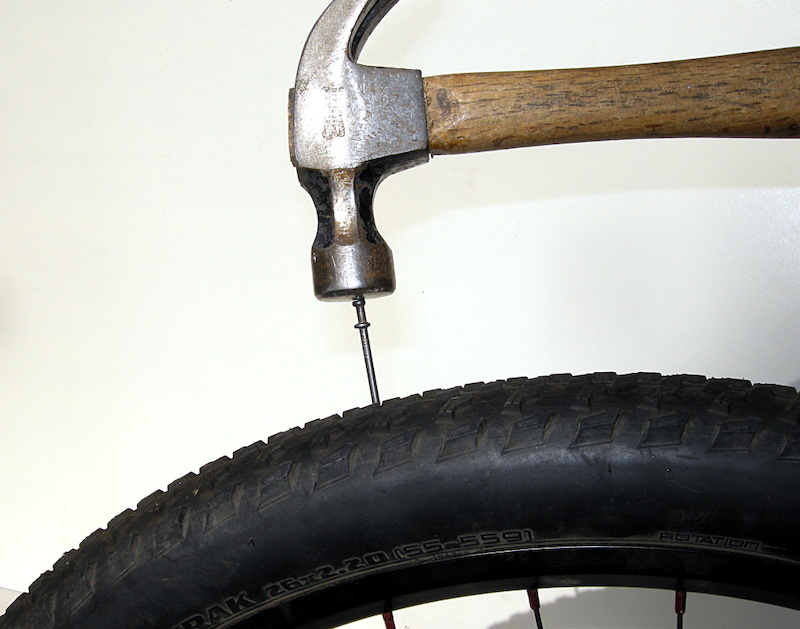 Whether you are new to cycling or an experienced rider,… Read More
Whether you are new to cycling or an experienced rider,… Read More
Author: hkc5twrt Fitness
Exercise-induced rhinitis: you may not have heard of it, but you may have experienced it. EIR is a common disorder associated with one or more symptoms including sneezing, runny nose, congestion… Read More
Author: hkc5twrt
Use our guide to help you determine your ideal mountain bike size. What size mountain bike do I need? This question is often asked - and for good reason, because choosing the right size ... Read more
Author: hkc5twrt Accessories
The connecting rod - often referred to as the crank mechanism - is one of the most important parts of a bicycle. As one of the key components that helps move the chain while pedaling, it is at the heart of… Read More
As one of the key components that helps move the chain while pedaling, it is at the heart of… Read More
Author: hkc5twrt Accessories
Froom points out friction and adjustment issues with the latest generation Shimano 9170 disc brakes. Chris Froome once again criticized the performance of disc brakes on road bikes, focusing on an unsolvable problem… Read more
Posted by hkc5twrt News
The International Cycling Union (UCI) has announced that going forward, all professional cyclists racing on the World Tour must install dropper stands on their bikes and use them on all descents. New… Read more
Author: hkc5twrt Reviews
The best tires for road bikes should be fast, light, supple and bouncy.